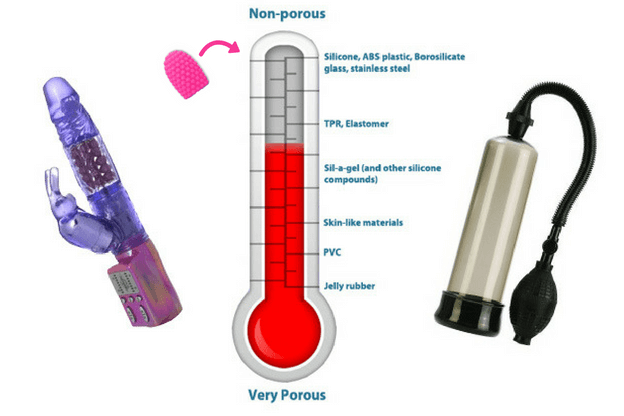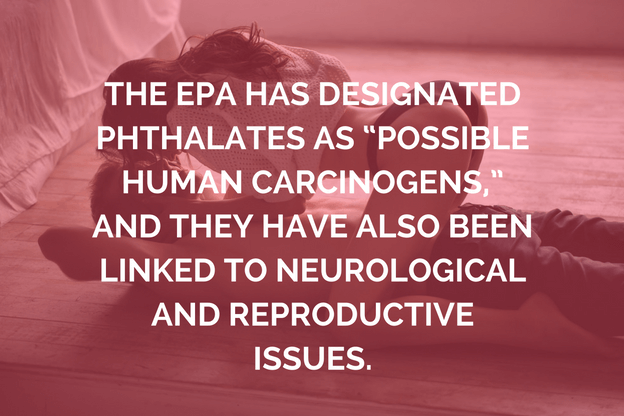
What on earth are sex toys made of, and are they body safe? Burke Denning writes about the science of sex toy health and safety.
By Burke Denning | Original title: The Safety Dance: Sex Toy Safety for a New Generation

Toy Porosity Thermometer
When entering an adult store to purchase a toy, few realize that safety may be one of the things to consider in their selection (alongside girth and vibration strength, of course!). Sex toys are made out of a wide variety of materials, but not all of them are safe to put inside your body. Let me break it down for you old-school:
Toy Material
The material of a toy is of particular importance when considering its safety for three reasons:
Porosity: This describes how porous or absorbent the material is. The more porous a material is, the more nooks and crannies there are for bacteria and the like to hide in—like a sponge. There, in the surface of a porous toy, bacteria can thrive and reproduce. Because they cannot be sterilized, porous toys should always be used with a condom, especially for anal use or when sharing of toys between partners.
A non-porous toy has a smooth, impermeable surface, like stainless steel, and does not retain and harbor bacteria in its surface. Many non-porous toys can be sterilized by boiling them in water or running them through the dishwasher (see manufacturer’s instructions). Regardless of porosity, it is always important to properly clean and maintain your toys.
Chemical composition: Some toys are made with chemicals that may not be safe for your body, and can cause itching, burning, rash and tissue damage. Phthalates (“thal-ates”) are a class of chemical plasticizers that are frequently added to the plastics used in sex toys (particularly PVC) to increase their flexibility, resulting in a softer, “squishier” feel to the toy material.
The EPA has designated phthalates as “possible human carcinogens,” and they have also been linked to neurological and reproductive issues. Phthalates are currently a controversial topic among regulation agencies around the world and are banned in several countries (including children’s toys the U.S.), and research is continually being done to pinpoint the dangers that they pose. No safety regulations currently exist for the sex toy industry, which means that any “phthalate-free” claims that adorn sex toy packaging are unverified and may be false.

“That’s why we keep phthalates out of our products” Lucy, CEO Viberry
Sex toys aren’t regulated: Currently, safety regulations do not exist in the sex toy industry; this is why sex toys are often labeled “sold as a novelty only.” The manufacturers are therefore not responsible for the negative consequences of any “unintended” (i.e. sexual, internal) use of their products.
This also means that manufacturers are not obligated to report the chemicals and materials used in a product to any higher regulatory body, and that they may report them inaccurately on their packaging without consequence. Consumers who wish to protect their health and remain informed will need to perform outside research to learn the true material composition of many toys on the market today.
What can you do?
Don’t be scared – be informed!
Phthalates can be super easy to detect in some toys. Look for these obvious warning signs:
- Read the package to determine the materials. Toys that contain PVC, vinyl, and jelly rubber often contain phthalates. Remember that any “phthalate-free” claims on the package aren’t necessarily true, even when coming from large, mainstream companies.
- Examine the toy out of the package.
- If a toy made from one of the above materials is “bendy” or “squishy,” plasticizers have been added to soften the material, and they are likely to be phthalates.
- When examining a toy that contains phthalates, you’ll often find “weeping,” or sweat-like beads of oily discharge on the surface of the material. This is caused by chemical degradation of the toy material, which occurs naturally over time as a toy sits on a shelf or in your bedroom.
- A strong, unpleasant, “rubbery” or “chemical-smelling” odor can often be detected coming off of toys and materials that contain phthalates. Note that many toys smell plastic-y or rubbery because, well, they’re made of plastic. However, phthalates have a distinctive kick that is easily identifiable to anyone familiar with the scent (some say it resembles the “new car” smell).
Stick to the Safe Stuff
The easiest way to pick safe and superior sex toys is to stick to high quality, hygienic materials from trusted manufacturers. Only buying toys made from medical grade materials is a simple, easy to remember policy that will keep you from harm’s way.
Medical grade materials are pricey (Note: this is what we use for the Viberry), and manufacturing costs are not lessened by cutting that material with cheaper materials, as is done with many less expensive sex toys (e.g. mixing silicone with PVC to make Sil-a-gel, which has the porosity of regular PVC, but with the high price tag of pure silicone).
You may have to pay top dollar, but you make a stress-free purchase and get a high quality, safe toy that will stay hygienic and last you for years and years (if you care for it properly!).
Do your Homework
Another way to choose safe and superior sex toys is to do your research and know your materials. Being informed about the myriad of materials out there allows you to shop competitively to protect your pocketbook AND your body. For example, instead of shelling out for a high-quality, medical-grade toy, get a TPR toy and a bottle of toy cleaner or a few packs of condoms.
Jelly rubber and other cheaper materials make for attractive purchases due to their low cost, making them good choices for first-time sex toy buyers who aren’t quite sure what they like yet. If you purchase or own a sex toy that is made from a porous material (or you aren’t quite sure what it’s made of!), be safe and make sure to slip a condom on that bad boy before each use.
Burke Denning is an MPH student at Indiana University, and is currently interning at the Kinsey Institute. Her studies are centered around the promotion of holistic sexual health and education that seeks to improve quality of life, and expands beyond the prevention and treatment of disease, dysfunction and unintended pregnancy. She is also a former adult retail (sex toy store) clerk, and lectures at IU on the topics of sex toy typology, safety, and regulation.
Kinsey Confidential™ is a sexuality information service designed by The Kinsey Institute for Research in Sex, Gender, and Reproduction™ to meet the sexual health information needs of college-age adults.
It’s beyond me how people buy a vibrator for $10 and then are shocked that it is full of toxins or it doesn’t work.